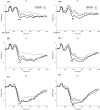Sports training enhances visuo-spatial cognition regardless of open-closed typology
- PMID: 28560098
- PMCID: PMC5444361
- DOI: 10.7717/peerj.3336
Sports training enhances visuo-spatial cognition regardless of open-closed typology
Abstract
The aim of this study was to investigate the effects of open and closed sport participation on visuo-spatial attention and memory performance among young adults. Forty-eight young adults-16 open-skill athletes, 16 closed-skill athletes, and 16 non-athletes controls-were recruited for the study. Both behavioral performance and event-related potential (ERP) measurement were assessed when participants performed non-delayed and delayed match-to-sample task that tested visuo-spatial attention and memory processing. Results demonstrated that regardless of training typology, the athlete groups exhibited shorter reaction times in both the visuo-spatial attention and memory conditions than the control group with no existence of speed-accuracy trade-off. Similarly, a larger P3 amplitudes were observed in both athlete groups than in the control group for the visuo-spatial memory condition. These findings suggest that sports training, regardless of typology, are associated with superior visuo-spatial attention and memory performance, and more efficient neural resource allocation in memory processing.
Keywords: Cognitive function; Event-related potential; Expertise; Sports.
Conflict of interest statement
Tsung-Min Hung is an Academic Editor for PeerJ.
Figures



References
-
- American College of Sports Medicine . ACSM’s guidelines for exercise testing and prescription. 7th edition Lippincott Williams & Wilkins; Philadelphia: 2006.
-
- Baayen RH, Milin P. Analyzing reaction times. International Journal of Psychological Research. 2010;3(2):12–28. doi: 10.21500/20112084.807. - DOI
-
- Chan JS, Wong AC, Liu Y, Yu J, Yan JH. Fencing expertise and physical fitness enhance action inhibition. Psychology of Sport and Exercise. 2011;12(5):509–514. doi: 10.1016/j.psychsport.2011.04.006. - DOI
-
- Chatrian G, Lettich E, Nelson P. Ten percent electrode system for topographic studies of spontaneous and evoked EEG activities. American Journal of EEG Technology. 1985;25(2):83–92.
LinkOut - more resources
Full Text Sources
Other Literature Sources

